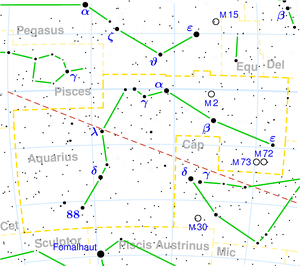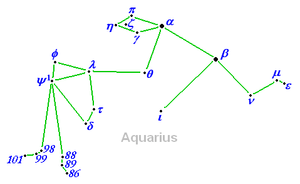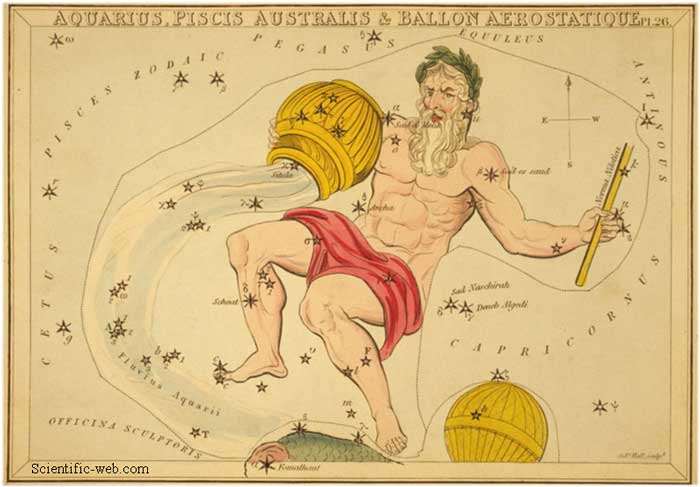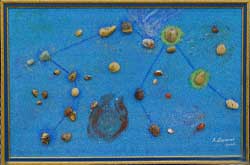.
Aquarius (constellation)
Aquarius ( Latin: water-bearer or cup-bearer) is the eleventh sign of the zodiac, situated between Capricornus and Pisces. Its symbol is (), Unicode ♒, representing part of a stream of water.
Aquarius is one of the oldest recognized constellations along the zodiac, the sun's apparent path. It is found in a region often called the Sea due to its profusion of watery constellations such as Cetus, Pisces, Eridanus, etc. Sometimes, the river Eridanus is depicted spilling from Aquarius' watering pot.
Notable planetary systems
* Gliese 876 is the first planetary system found around the red dwarf star. The planetary system has three planets, including one terrestrial planet 6-8 times the mass of Earth.
* 91 Aquarii b is a planet found around the orange giant star. The mass is 2.9 times Jupiter and the semimajor axis of 0.3 AU.
* Gliese 849 b is the first long-period Jupiter-like planet found around the red dwarf star. The semimajor axis is 2.35 AU and has mass of 0.82 Jupiter.
Notable deep sky objects
There are three deep sky objects that are on the Messier catalog: the globular clusters Messier 2, Messier 72, and the open cluster Messier 73.
Two well-known planetary nebulae are located in Aquarius: the Saturn Nebula (NGC 7009), to the southwest of η Aquarii; and the famous Helix Nebula (NGC 7293), southwest of δ Aquarii.
Mythology
The best-known myth identifies Aquarius with Ganymede, a beautiful youth with whom Zeus fell in love, and whom he (in the disguise of an eagle, represented as the constellation Aquila) carried off to Olympus to be cup bearer to the gods. Crater is sometimes identified as his cup.
Aquarius generally resembles the figure of a man, and when considering fainter humanly visible stars, it takes on the image of a man with a bucket from which is pouring a stream. Aquarius was also identified as the pourer of the waters which flooded the earth in the Great Flood, in the ancient Greek version of the myth. As such, the constellation Eridanus was sometimes identified as being a river poured out by Aquarius.
It may also, together with the constellation Pegasus, be part of the origin of the myth of the Mares of Diomedes, which forms one of The Twelve Labours of Heracles. Its association with pouring out rivers, and the nearby constellation of Capricornus, may be the source of the myth of the Augean stable, which forms another of the labours.
Astrology
The Western astrological sign Aquarius of the tropical zodiac (January 20/21–February 18/19)[a] differs from the astronomical constellation and the Hindu astrological sign of the sidereal zodiac (February 16–March 11).
Individuals born under the Aquarius sign are, by western astrologers, thought to have a creative, progressive (sometimes rebellious), and independent character.
According to astrology-inspired New Age mythology, and according to the gospel of The 5th Dimension, we're now living in the Age of Aquarius. Each Age is 2000 years long, approximately, with the Precession of the Equinoxes marking the beginning and end of each Age.
Alternative visualization
Diagram of an alternate way to connect the stars of the Aquarius constellation. The water bearer is shown running while holding a vessel and spilling some water out of that vessel.
of barney α Aqr, γ Aqr, η Aqr, and π Aqr: α Aqr being of the third magnitude. Star ζ Aqr, lodged within the quadrangle, represents an eye.
The water bearer's torso is formed by the stars α Aqr and β Aqr, with β Aqr being of the third magnitude.
The water bearer's left leg is formed by the stars β Aqr and ι Aqr, whereas his right leg is formed by the stars β Aqr, ν Aqr, μ Aqr, and ε Aqr, with these last two stars representing a foot.
The water bearer's arm is formed by the stars α Aqr, θ Aqr, and λ Aqr, with λ Aqr being the hand.
The water bearer is holding a vessel, perhaps a jar, which is formed by the stars ψ¹ Aqr, φ Aqr, λ Aqr, τ Aqr, and δ Aqr. The open top of the vessel consists of the triangle of stars ψ¹ Aqr, φ Aqr, and λ Aqr.
Water is being poured from the vessel in a pair of streamlines. The streamline on the left is formed by the stars ψ¹ Aqr, 98 Aqr, 99 Aqr, and 101 Aqr. The streamline on the right is formed by the stars ψ¹ Aqr, 88 Aqr, 89 Aqr, and 86 Aqr.
See also
* List of stars in Aquarius
Notes
^ a. Depending on the source, the dates are either from January 21 to February 19, or from January 20 to February 18.
References
* Ian Ridpath and Wil Tirion (2007). Stars and Planets Guide, Collins, London. ISBN 978-0007251209. Princeton University Press, Princeton. ISBN 978-0691135564.
* H. A. Rey, The Stars — A New Way To See Them. Enlarged World-Wide Edition. Houghton Mifflin, Boston, 1997. ISBN 0-395-24830-2.
Links
|
The 88 modern constellations
Andromeda | Antlia | Apus | Aquarius | Aquila | Ara | Aries | Auriga | Boötes | Caelum | Camelopardalis | Cancer | Canes Venatici | Canis Major | Canis Minor | Capricornus | Carina | Cassiopeia | Centaurus | Cepheus | Cetus | Chamaeleon | Circinus | Columba | Coma Berenices | Corona Australis | Corona Borealis | Corvus | Crater | Crux | Cygnus | Delphinus | Dorado | Draco | Equuleus | Eridanus | Fornax | Gemini | Grus | Hercules | Horologium | Hydra | Hydrus | Indus | Lacerta | Leo | Leo Minor | Lepus | Libra | Lupus | Lynx | Lyra | Mensa | Microscopium | Monoceros | Musca | Norma | Octans | Ophiuchus | Orion | Pavo | Pegasus | Perseus | Phoenix | Pictor | Pisces | Piscis Austrinus | Puppis | Pyxis | Reticulum | Sagitta | Sagittarius | Scorpius | Sculptor | Scutum | Serpens | Sextans | Taurus | Telescopium | Triangulum | Triangulum Australe | Tucana | Ursa Major | Ursa Minor | Vela | Virgo | Volans | Vulpecula |
Retrieved from "http://en.wikipedia.org/"
All text is available under the terms of the GNU Free Documentation License





